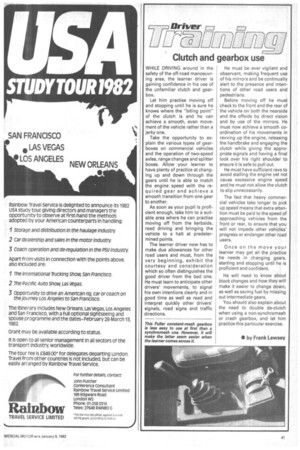Clutch and gearbox use
Page 41

If you've noticed an error in this article please click here to report it so we can fix it.
WHILE DRIVING around in the safety of the off-road manoeuvring area, the learner driver is gaining confidence in his use of the unfamiliar clutch and gearbox.
Let him practise moving off and stopping until he is sure he knows where the "biting point" of the clutch is and he can achieve a smooth, even movement of the vehicle rather than a jerky one.
Take the opportunity to explain the various types of gearboxes on commercial vehicles and the operation of two-speed axles, range changes and splifter boxes. Allow your learner to have plenty of practice at changing up and down through the gears until he is able to match the engine speed with the required gear and achieve a smooth transition from one gear to another.
As soon as your pupil is proficient enough, take him to a suitable area where he can practise moving off from the kerbside, road driving and bringing the vehicle to a halt at predetermined points.
The learner driver now has to make due allowances for other road users and must, from the very beginning, exhibit the courtesy and consideration which so often distinguishes the good driver from the bad one. He must learn to anticipate other drivers' movements, to signal his own intentions clearly and in good time as well as read and interpret quickly other drivers' signals, road signs and traffic directions, He must be ever vigilant and observant, making frequent use of his mirrors and be continually alert to the presence and intentions of other road users and pedestrians.
Before moving off he must check to the front and the rear of the vehicle on both the nearside and the offside by direct vision and by use of the mirrors. He must now achieve a smooth coordination of his movements in revving up the engine, releasing the handbrake and engaging the clutch while giving the appropriate signals and having a final look over his right shoulder to ensure it is safe to pull out.
He must have sufficient revs to avoid stalling the engine yet not cause excessive engine speed and he must not allow the clutch to slip unnecessarily.
The fact that heavy commercial vehicles take longer to pick up speed means that extra attention must be paid to the speed of approaching vehicles from the front or rear, to ensure that you will not impede other vehicles' progress or endanger other road users.
Once on the move your learner may get all the practice he needs in changing gears, starting and stopping until he is proficient and confident.
He will need to know about block changes and how they will make it easier to change down, as well as saving fuel by missing out intermediate gears.
You should also explain about the need to double de-clutch when using a non-synchromesh or crash gearbox, and let him practice this particular exercise.
• by Frank Lewsey










































